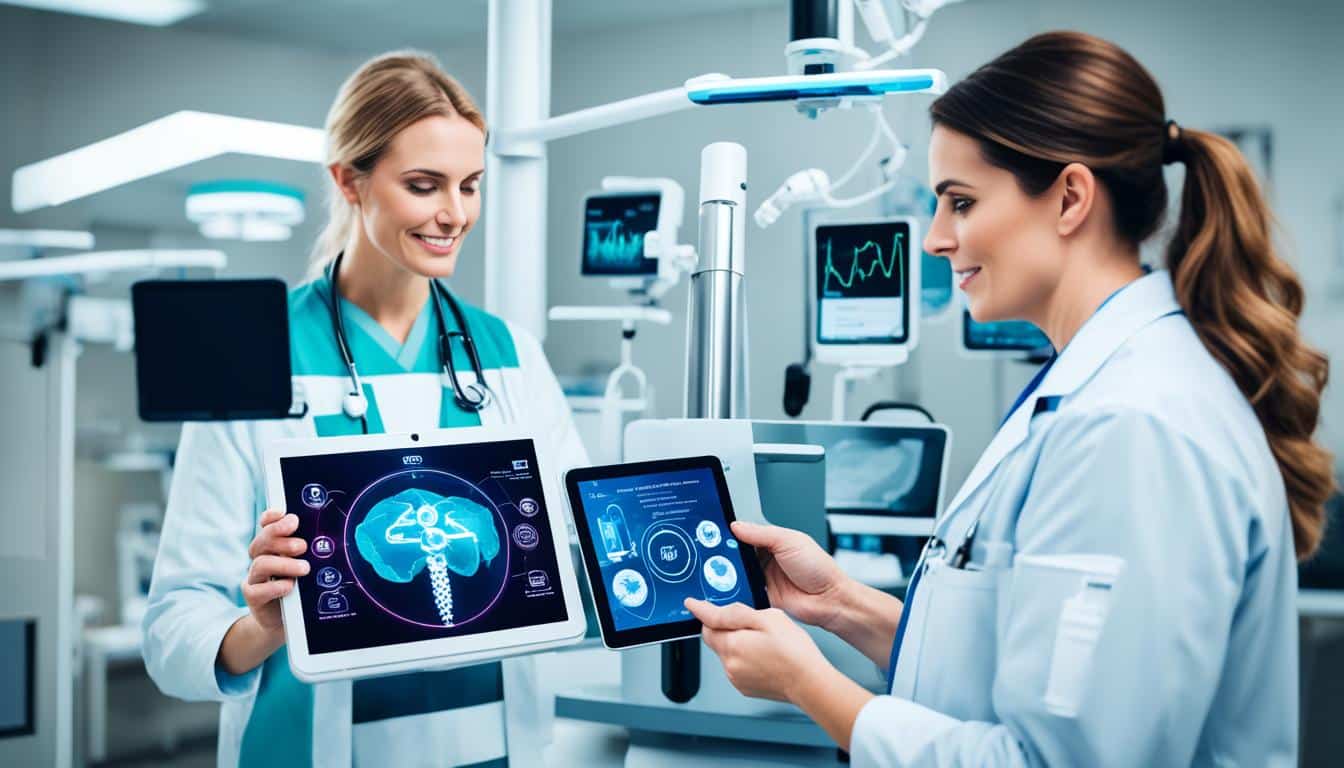5G technology has the potential to have a transformative effect on healthcare by revolutionizing wireless networks. With faster and more reliable connections, 5G can significantly enhance patient care and improve the overall efficiency of healthcare services. By integrating 5G technology into the healthcare ecosystem, numerous opportunities for innovation and improvement in various aspects of healthcare delivery arise.
Key Takeaways : 5G Technology
- 5G technology has the potential to revolutionize healthcare by providing faster and more reliable wireless networks.
- The integration of 5G technology into the healthcare ecosystem presents numerous opportunities for innovation and improvement in various aspects of healthcare delivery.
- 5G wireless networks offer immense opportunities for healthcare providers to introduce innovative applications and improve clinical outcomes.
- The implementation of 5G technology in healthcare brings several benefits such as fast file transmission, teleconsultation, contact tracing, and robot-assisted services.
- 5G technology enables fully remote surgeries, remote patient monitoring, medical training through advanced simulations, and connected ambulances for improved emergency response and patient care.
The Opportunities of 5G in Healthcare
5G wireless networks present healthcare providers with a multitude of opportunities to introduce innovative applications and enhance clinical outcomes. By integrating 5G with other cutting-edge technologies such as artificial intelligence (AI), the Internet of Things (IoT), and telemedicine, healthcare services can be revolutionized, paving the way for more accurate and personalized patient care.
The transformative power of 5G lies in its ability to enable seamless and fast communication between healthcare professionals, patients, and devices. This technology enables healthcare providers to securely transmit and analyze vast amounts of data, leading to breakthroughs in screening, diagnosis, monitoring, and treatment processes.
One of the key advantages of 5G wireless networks is their capacity to support innovative applications that were previously challenging due to bandwidth limitations. With the high-speed connectivity and low latency offered by 5G, healthcare providers can leverage advanced AI algorithms for real-time analysis of medical data, improving diagnostic accuracy and treatment planning.
Moreover, the integration of 5G with IoT devices allows for efficient remote patient monitoring, enabling healthcare professionals to collect real-time vitals and track patients’ health conditions outside of traditional healthcare settings. This capability is particularly valuable for patients with chronic illnesses who require ongoing monitoring and personalized interventions.
Enhancing Clinical Applications with 5G
By harnessing the power of 5G wireless networks, healthcare providers can enhance various clinical applications that contribute to better patient outcomes. For example, with the seamless connectivity provided by 5G, telemedicine services can be expanded and improved, allowing patients to receive remote consultations and access specialized healthcare regardless of their geographical location.
5G opens up new possibilities for innovation and efficiency in healthcare delivery.”
Another area where 5G can make a significant impact is in the realm of surgical procedures. The combination of 5G’s high bandwidth and low latency with robotic-assisted surgical systems enables surgeons to perform complex surgeries remotely. This advancement eliminates geographical barriers and enhances collaboration between healthcare professionals, leading to improved surgical outcomes.
Integrated Technologies for Improved Healthcare
When integrated with other technologies, such as AI and IoT, 5G enhances the overall efficiency and effectiveness of healthcare delivery. By leveraging AI algorithms, healthcare providers can analyze vast amounts of medical data in real-time, leading to quicker and more accurate diagnoses. This can ultimately lead to earlier interventions and improved patient outcomes.
| Integrated Technologies | Potential Benefits |
|---|---|
| AI | Real-time analysis of medical data for accurate diagnoses and personalized treatment plans |
| IoT | Remote patient monitoring, enabling timely interventions and personalized care |
| Telemedicine | Expanded access to specialized healthcare services through remote consultations |
By embracing the opportunities presented by 5G wireless networks and integrating various technologies, healthcare providers can revolutionize the way healthcare services are delivered. The advancements made possible by 5G have the potential to improve patient care, enhance diagnostic accuracy, and drive innovation in healthcare practices.
Benefits of 5G Technology in Healthcare
The implementation of 5G technology in healthcare brings several benefits that revolutionize the way healthcare professionals deliver services and enhance patient care.
One of the key advantages of 5G is its ability to enable fast and efficient file transmission. Healthcare professionals can now quickly transfer large files, such as diagnostic imaging files, with minimal delay. This ensures seamless collaboration between healthcare providers and expedited access to crucial medical information.
Furthermore, 5G facilitates teleconsultation, eliminating the need for in-person visits for non-emergency cases. Patients can now receive medical advice and consultations remotely, saving time and reducing unnecessary physical contact. This is especially beneficial for patients with limited mobility or those residing in remote areas.
5G also plays a vital role in supporting contact tracing efforts during the spread of infectious diseases. With real-time traceability enabled by 5G networks, healthcare organizations can monitor and track the movement of individuals, helping to identify potential sources of infection and implement timely control measures.
Another significant benefit of 5G technology is the potential for robot-assisted services in healthcare. By leveraging the high bandwidth and low latency of 5G networks, healthcare professionals can adopt robots to perform various tasks, such as delivering medication to patients or disinfecting hospital rooms. This integration of robotic services enhances efficiency, reduces the workload on medical staff, and improves overall patient care.
5G’s capabilities also extend to enabling fully remote surgeries. By leveraging the high-speed and low-latency connectivity of 5G, surgeons can perform intricate procedures in real-time, remotely controlling robotic surgical systems. This breakthrough allows expert surgeons to deliver their skills to patients worldwide, regardless of geographical boundaries, improving access to specialized healthcare.
In addition, 5G technology empowers healthcare professionals with remote monitoring capabilities. Connected devices and IoT trackers, combined with 5G’s real-time connectivity, enable healthcare providers to monitor patients remotely. This includes real-time vitals monitoring, ensuring timely intervention, and personalized care. Video feedback can be incorporated to guide patients in following medication instructions correctly, further enhancing treatment effectiveness.
With 5G technology, medical training is also transformed. The high bandwidth and low latency inherent in 5G networks enable seamless integration of augmented reality (AR) and virtual reality (VR) applications for medical training. Through advanced simulations, healthcare professionals can gain realistic, hands-on experience to refine their skills, ultimately delivering better patient outcomes.
Lastly, the implementation of 5G in healthcare extends to connected ambulances. Equipped with 5G technology, ambulances can establish a stable connection to healthcare networks, enabling real-time transmission of vital information to medical professionals before arriving at the hospital. This ensures that appropriate resources and care are prepared in advance, maximizing the chances of saving lives.
Through these various applications, 5G technology is reshaping the healthcare landscape by improving file transmission, enabling teleconsultation, supporting contact tracing, facilitating robot-assisted services, enabling fully remote surgeries, enhancing remote monitoring, revolutionizing medical training, and empowering connected ambulances. The benefits of 5G technology in healthcare are vast and promising, ultimately leading to better patient care, improved efficiency, and transformative advancements in the field.
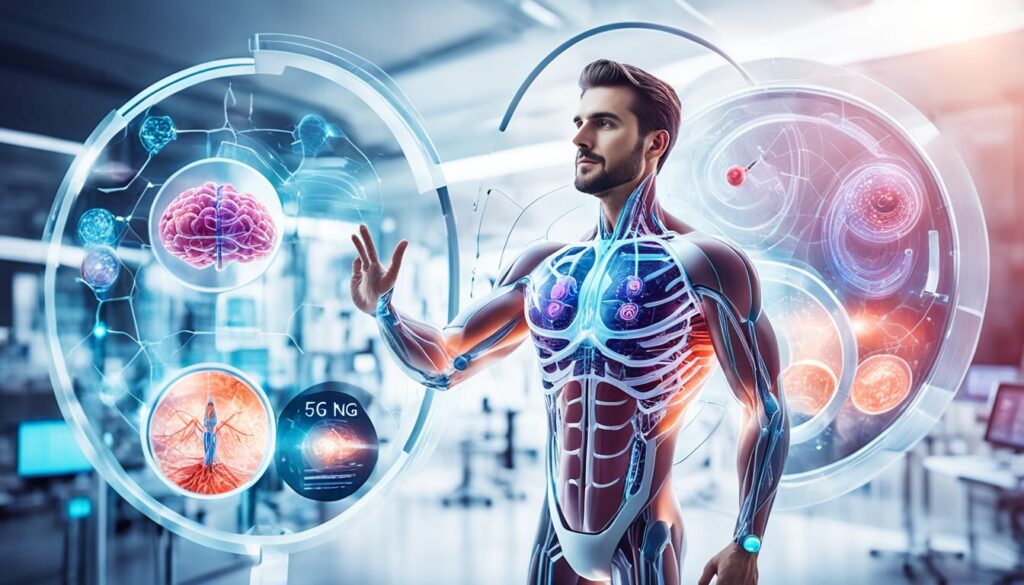
File Transmission with 5G
File transmission is a critical aspect of healthcare operations, and 5G connectivity offers significant advantages in this area. With its enhanced mobile broadband (eMBB) features, 5G allows for faster and more efficient transfer of large files, including diagnostic imaging files. This capability has a profound impact on healthcare providers by streamlining administrative tasks and improving overall workflow efficiency.
Healthcare professionals no longer need to wait for extended periods to transfer essential files. Thanks to 5G connectivity, file transfer times are reduced to a matter of seconds, enabling quick access to patient records, medical images, and other critical documents. This efficient transfer of diagnostic imaging files, for example, ensures that healthcare professionals can seamlessly access and review patient scans, such as X-rays, CT scans, and MRIs, without any delays or interruptions.
The enhanced mobile broadband capabilities of 5G enable healthcare providers to transmit large files rapidly while maintaining the integrity and quality of the data. This is particularly crucial in the context of diagnostic imaging files, which often contain high-resolution images that demand substantial network bandwidth to transmit effectively.
The integration of 5G technology allows healthcare providers to transfer diagnostic imaging files within seconds, improving patient care and workflow efficiency. This means that healthcare professionals can access crucial patient information faster and make timely decisions, leading to improved patient outcomes.
Efficient file transmission with 5G also has broader implications for healthcare operations. It enables seamless collaboration among healthcare professionals, allowing them to share and access files remotely, even across different healthcare facilities. This capability facilitates smoother information exchange, optimizes care coordination, and enhances interdisciplinary collaboration.
Benefits of 5G Connectivity for File Transmission:
- Rapid transfer of large files, including diagnostic imaging files
- Enhanced access to patient records and medical images
- Improved workflow efficiency and reduced administrative burden
- Promotes seamless collaboration and interdisciplinary communication
- Enhances patient outcomes through expedited information exchange
With the transformative power of 5G connectivity, healthcare providers can experience significant improvements in file transmission, ensuring efficient and seamless access to critical patient information. This advancement leads to enhanced patient care delivery, streamlined workflows, and improved overall healthcare outcomes.
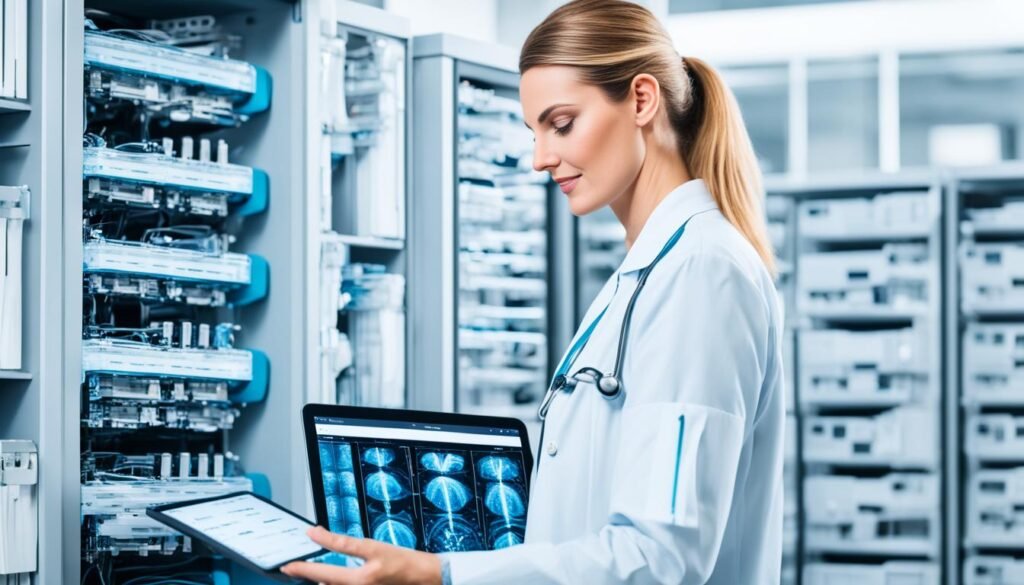
Teleconsultation with 5G
Teleconsultation services in healthcare have gained significant momentum in recent years, driven by the need for remote healthcare access and convenience. With the increasing demand for digital health consultations, 5G connectivity is playing a crucial role in delivering reliable and seamless video communication between patients and healthcare professionals.
5G technology provides a reliable network service that ensures high-quality video calls, eliminating connectivity issues and enabling efficient remote consultations. This fast and reliable wireless connection offered by 5G enhances the overall telehealth experience, reducing the need for in-person visits for minor health issues.
By leveraging 5G connectivity, healthcare providers can offer a range of digital health services, including:
- Real-time video consultations
- Remote monitoring and follow-ups
- Prescription refills
- Medical advice and triaging
- Access to specialists and second opinions
This advanced level of telehealth services powered by 5G connectivity delivers benefits to both patients and healthcare professionals. For patients, it provides increased access to healthcare services from the comfort of their homes, saving time and reducing travel costs. Healthcare professionals can efficiently manage their patient load, optimize their schedules, and extend their reach to remote areas.
5G connectivity revolutionizes teleconsultation, enabling enhanced patient care and improved access to healthcare services. With its reliable network service, patients and healthcare professionals can connect seamlessly, ensuring high-quality video consultations without disruptions. This transformative technology is shaping the future of telehealth, offering convenient and efficient digital health consultations.
Case Study: Mayo Clinic
The Mayo Clinic, a renowned healthcare organization, has embraced 5G technology to expand its telehealth capabilities and provide enhanced healthcare services. With 5G connectivity, they have been able to offer real-time video consultations, remote monitoring, and virtual care options to patients across various locations.
| Benefits of 5G for Mayo Clinic | Impacts |
|---|---|
| High-quality video consultations | Improved patient engagement and satisfaction |
| Remote monitoring | Effective management of chronic conditions |
| Virtual care options | Expanded access to specialized care |
| Reduced travel for patients | Convenience and cost savings |
The Mayo Clinic’s successful integration of 5G technology showcases the potential of teleconsultation in delivering exceptional healthcare services and improving patient outcomes.
In conclusion, 5G connectivity is revolutionizing teleconsultation services in healthcare, empowering patients and healthcare professionals with efficient and high-quality digital health consultations. As the adoption of 5G technology continues to grow, the telehealth landscape will witness further advancements, shaping the future of healthcare by providing accessible and personalized virtual care.
Contact Tracing with 5G
One of the key applications of 5G networks in healthcare is contact tracing, which plays a crucial role in monitoring the spread of infectious diseases. With the integration of the internet of things (IoT) technologies, 5G enables real-time traceability, allowing healthcare organizations to track the movement of individuals and implement timely intervention and control measures.
Contact tracing is particularly essential in situations like the COVID-19 pandemic, where identifying and isolating individuals who have come into contact with an infected person is vital for containing the spread of the virus. By utilizing IoT trackers connected to the 5G network, healthcare professionals can monitor the location and interactions of individuals in real-time, enabling them to quickly identify potential infection chains and take appropriate actions.
5G networks, in combination with IoT technologies, provide the necessary infrastructure for effective contact tracing in healthcare. The ability to track individuals in real-time allows healthcare organizations to respond swiftly and implement targeted measures to prevent further transmission of infectious diseases.
The real-time traceability offered by 5G networks enhances the accuracy and efficiency of contact tracing efforts. It eliminates the reliance on manual contact tracing methods, which can be time-consuming and prone to errors. With 5G-powered IoT trackers, healthcare organizations can access up-to-date information that helps them identify high-risk individuals or locations and implement preventive measures promptly.
Furthermore, the combination of 5G networks and IoT enables continuous monitoring of individuals, even in dynamic environments. Traditional contact tracing methods may not capture real-time changes in an individual’s location or interactions. However, with 5G’s low latency and high bandwidth, data from IoT trackers can be transmitted rapidly, providing healthcare professionals with a comprehensive and accurate picture of an individual’s movements and potential exposure risks.
Benefits of Contact Tracing with 5G:
- Real-time monitoring and traceability of individuals
- Swift identification of potential infection chains
- Targeted implementation of preventive measures
- Elimination of manual contact tracing errors
- Continuous monitoring in dynamic environments
Through the synergy of 5G networks and IoT technologies, healthcare organizations can leverage contact tracing to proactively mitigate the spread of infectious diseases. The real-time traceability provided by 5G networks enables swift intervention, protecting both individuals and communities from the potential harms of outbreaks.
| Benefits of Contact Tracing with 5G | Description |
|---|---|
| Real-time monitoring and traceability of individuals | 5G networks enable continuous tracking of individuals’ movements and interactions, allowing for real-time monitoring and traceability. |
| Swift identification of potential infection chains | By analyzing real-time data from IoT trackers, healthcare professionals can quickly identify potential infection chains and take timely action. |
| Targeted implementation of preventive measures | The accurate and up-to-date information provided by 5G-powered contact tracing facilitates targeted implementation of preventive measures in high-risk areas or individuals. |
| Elimination of manual contact tracing errors | 5G eliminates the reliance on manual contact tracing methods, reducing errors and improving the accuracy and efficiency of the process. |
| Continuous monitoring in dynamic environments | With the low latency and high bandwidth of 5G, IoT trackers can provide continuous monitoring of individuals in dynamic environments, capturing real-time changes in location and interactions. |
By harnessing the power of 5G networks and IoT technologies for contact tracing, healthcare organizations can effectively contain the spread of infectious diseases, safeguarding public health and enabling swift response to outbreaks.
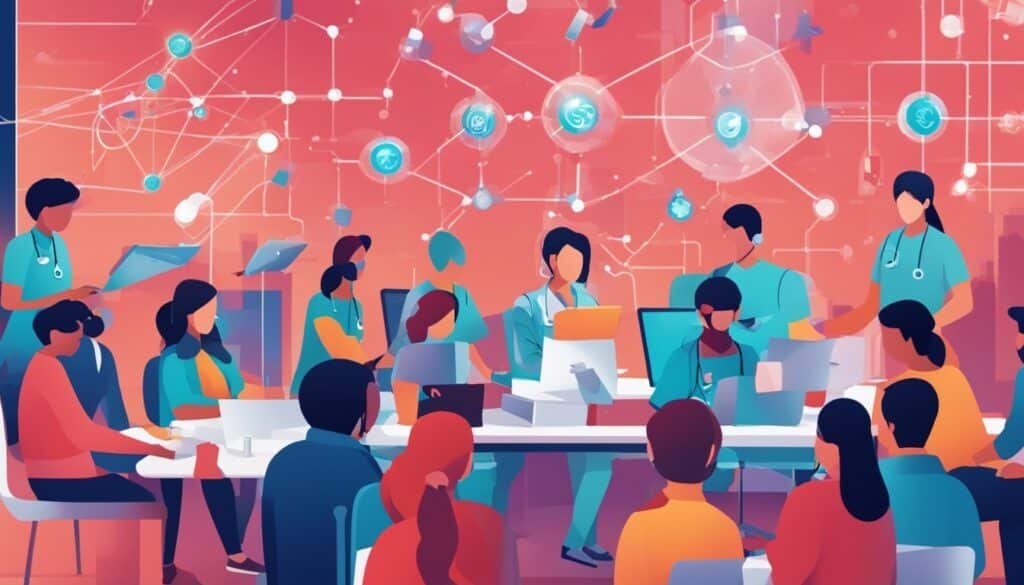
Robot-Assisted Services with 5G
One of the significant benefits of 5G technology in healthcare is its role in enabling robot-assisted services. These services leverage the power of robotics to perform a variety of tasks within healthcare settings, from taking blood samples and disinfecting hospital rooms to delivering medication to patients. By integrating 5G connectivity into these robotic healthcare operations, the workload of medical staff can be alleviated, leading to enhanced overall efficiency in healthcare delivery.
The automation of routine tasks through robot-assisted services can significantly reduce the burden on healthcare professionals, allowing them to focus on critical patient care. Robots equipped with advanced technologies and sensors can perform these tasks more accurately and consistently, minimizing errors and improving patient safety.
With 5G technology, the real-time communication between robots and healthcare systems becomes seamless and efficient. The high-speed and low-latency characteristics of 5G networks enable instant data transmission and receive feedback. This real-time interaction allows robots to perform tasks effectively, ensuring prompt responses to changing patient needs.
Additionally, the integration of 5G with the latest chipsets that support Time-Sensitive Networking (TSN) is crucial for the successful implementation of these robotic services. TSN enables precise synchronization and deterministic communication between robots and other healthcare devices, ensuring reliable and coordinated operations.
Furthermore, 5G technology enables the integration of robots with other advanced technologies like artificial intelligence (AI) and the Internet of Things (IoT). This integration enhances the capabilities of robots, enabling them to adapt to dynamic healthcare environments and perform complex tasks with precision.
The integration of 5G technology, robotic healthcare operations, and automation has the potential to optimize medical staff workload and improve patient care outcomes. By leveraging the power of robotics and advanced connectivity, healthcare providers can enhance operational efficiency while ensuring high-quality care for patients.
Example Use Case: Hospital Cleaning and Disinfection Robots
“Hospital cleaning and disinfection robots equipped with 5G technology can autonomously navigate through healthcare facilities, ensuring thorough and efficient cleaning. These robots are equipped with sensors and AI capabilities to detect and eliminate harmful pathogens, reducing the risk of infections. With 5G connectivity, real-time monitoring and remote control of these robots can be achieved, enabling healthcare staff to optimize cleaning protocols and focus on critical patient care.”
By embracing robot-assisted services powered by 5G technology, healthcare providers can streamline operations, improve the quality of care, and enhance the overall patient experience. The integration of advanced robotics and 5G connectivity paves the way for a more efficient and technologically advanced healthcare system.
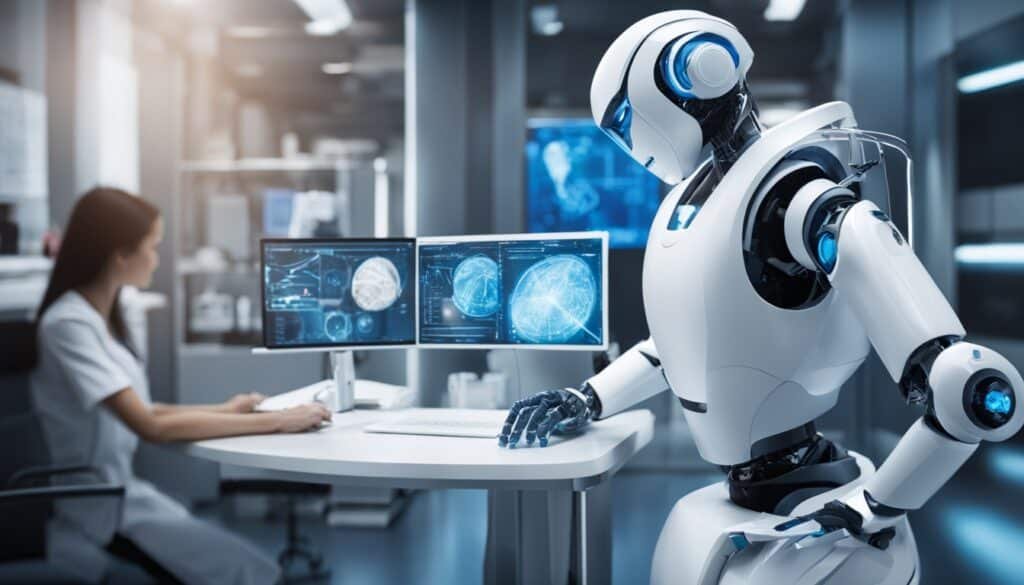
| Benefits of Robot-Assisted Services with 5G | Keywords |
|---|---|
| Reduced workload for medical staff | medical staff workload |
| Enhanced operational efficiency | automation |
| Improved patient safety and outcomes | robotic healthcare operations |
| Real-time communication between robots and healthcare systems | integration with chipsets |
| Precise synchronization and coordinated operations | integration with chipsets |
Fully Remote Surgeries with 5G
The advancement of 5G technology has paved the way for groundbreaking developments in the healthcare industry. One of the most remarkable applications is the capability to perform fully remote surgeries, leveraging the power of 5G connectivity. By harnessing the high bandwidth and low latency of 5G networks, surgeons can now operate on patients from a remote location with real-time transmission of video footage and haptic feedback.
In a fully remote surgery, the surgeon relies on the assistance of robots and cutting-edge technology to perform complex procedures. With the seamless real-time transmission enabled by 5G, surgeons can effectively navigate the surgical site with precision, just as if they were physically present in the operating room. This level of remote control and accuracy is made possible by the high-speed and reliable connection provided by 5G connectivity.
The success of fully remote surgeries with 5G depends on the advanced network capabilities and precise communication between the surgeon and the robotic surgical system. The high bandwidth ensures that video feeds are transmitted smoothly and without any significant delays, allowing the surgeon to make real-time decisions based on the live surgical images. Low latency, on the other hand, guarantees that there is minimal delay between the surgeon’s instructions and the execution by the robotic system, ensuring precise movements and immediate feedback.
5G connectivity is instrumental in overcoming the limitations of traditional surgeries and geographical barriers. By enabling fully remote surgeries, it revolutionizes healthcare delivery, making specialized surgical expertise accessible to patients regardless of their location.
This groundbreaking application of 5G technology brings numerous benefits to both patients and healthcare providers. For patients, it means access to cutting-edge surgical procedures without the need for travel or long waiting times. It eliminates geographical restrictions and improves patient outcomes through quicker intervention and access to the best surgical expertise available.
For healthcare providers, fully remote surgeries with 5G offer increased efficiency and cost-effectiveness. Surgeons can perform multiple surgeries from a central location, optimizing their time and expertise. It also opens up opportunities for collaboration and knowledge sharing among surgeons worldwide. The real-time transmission of surgical procedures can be used for training purposes, enhancing the education and skills of future surgeons.
The Future of Remote Surgeries
As 5G technology continues to mature, the potential for fully remote surgeries will expand even further. With the constant evolution of robotics and artificial intelligence, surgical robots will become more advanced and capable, allowing surgeons to perform increasingly complex procedures remotely. The integration of 5G with emerging technologies, such as augmented reality and machine learning, will further enhance the capabilities of remote surgeries, promising safer and more precise surgical interventions.
Moreover, the combination of 5G connectivity and real-time data analytics will enable surgeons to access vital patient information during surgeries, enhancing decision-making and surgical outcomes. Remote surgeries with 5G have the potential to transform healthcare delivery, bringing specialized surgical expertise to underserved areas, reducing surgical disparities, and improving patient care on a global scale.
| Advantages of Fully Remote Surgeries with 5G | Benefits |
|---|---|
| Geographical accessibility | Patients can access specialized surgical expertise regardless of their location, eliminating the need for travel. |
| Real-time transmission | Surgeons can perform surgeries with live video feeds and haptic feedback, replicating the experience of being in the operating room. |
| Efficiency and cost-effectiveness | Surgeons can perform multiple surgeries remotely, optimizing time and resources, and reducing the overall cost of healthcare delivery. |
| Collaboration and knowledge sharing | Surgeons can collaborate and share expertise globally, benefiting from real-time transmission for training and education purposes. |
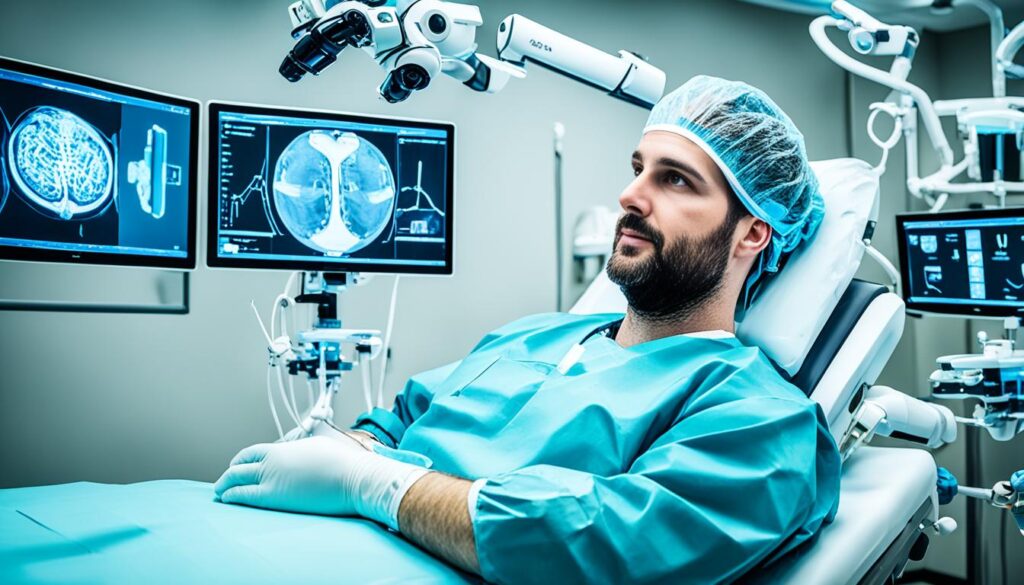
Remote Monitoring with 5G
Remote patient monitoring is a vital application of 5G technology in healthcare. With the help of IoT trackers and high-speed wireless connectivity, healthcare professionals can continuously monitor the vital signs of patients from a remote location. This real-time monitoring allows for prompt intervention in case of any health issues, ensuring that patients receive timely care and attention.
The use of IoT trackers enables the collection of real-time data on parameters such as heart rate, blood pressure, and oxygen levels. These devices can be easily worn by patients and transmit data wirelessly to healthcare providers. The high-speed and low-latency capabilities of 5G technology ensure that this data is transmitted quickly and accurately, facilitating real-time vitals monitoring.
Real-time vitals monitoring through remote patient monitoring has several benefits. It allows healthcare professionals to closely track patients’ health conditions without the need for frequent hospital visits. This remote monitoring can be particularly useful for patients with chronic conditions who require continuous monitoring but would prefer to remain in the comfort of their homes.
“Remote patient monitoring with 5G has revolutionized the way we provide healthcare. It allows us to keep a close eye on our patients’ health, even from a distance, and intervene quickly when necessary. This technology has truly improved the quality of care we can offer.” – Dr. Sarah Thompson, Cardiologist
Video feedback is another valuable aspect of remote patient monitoring enabled by 5G technology. Healthcare providers can utilize video calls to interact with patients and visually assess their progress. This feature is particularly useful for medication adherence, where healthcare professionals can ensure that patients are correctly following medication instructions and provide feedback accordingly.
Furthermore, the combination of remote patient monitoring and 5G technology allows for improved diagnostics. Healthcare professionals can access real-time data and make more accurate assessments of patients’ health conditions. This can lead to earlier detection of potential problems and more effective treatment strategies.
The integration of 5G technology into remote monitoring has unlocked a range of possibilities in the healthcare industry. With its high-speed wireless connectivity and real-time data transmission capabilities, 5G has significantly enhanced remote monitoring, improving patient care and outcomes.
Benefits of Remote Monitoring with 5G:
- Continuous monitoring of vital signs
- Reduced need for frequent hospital visits
- Improved medication adherence through video feedback
- Early detection of potential health issues
- Enhanced accuracy in diagnostics
Medical Training with 5G
Medical training has evolved significantly with the integration of 5G technology. The high bandwidth and low latency provided by 5G enable the development of innovative AR/VR applications that enhance medical simulations and provide more realistic training experiences for healthcare professionals.
Through these advanced applications, trainees can immerse themselves in virtual environments that closely mimic real-life medical scenarios. With the use of AR/VR applications, healthcare professionals can gain hands-on experience, refine their skills, and improve patient care outcomes.
Realistic Training Experiences for Enhanced Learning
Using AR/VR applications powered by 5G technology, medical trainees can engage in interactive simulations that offer a realistic representation of medical procedures and scenarios. This immersive training environment allows trainees to practice critical procedures, such as performing surgeries or diagnosing complex medical conditions, in a controlled yet realistic setting.
The integration of 5G’s high bandwidth and low latency ensures a seamless and immersive experience for trainees, enabling them to make decisions and execute actions with minimal delay. This real-time responsiveness enhances the learning process and facilitates the acquisition of practical skills.
Minimizing Medical Errors for Enhanced Patient Safety
One of the primary benefits of medical training with 5G and AR/VR applications is the potential to minimize medical errors. By providing a realistic training environment, healthcare professionals can familiarize themselves with challenging procedures and scenarios before encountering them in real-life patient care.
This advanced training approach enables healthcare professionals to refine their techniques, practice critical decision-making, and develop a deeper understanding of complex medical conditions. As a result, medical errors can be reduced, and patient safety can be enhanced.
High Bandwidth and Low Latency Driving Advanced Simulations
The integration of 5G’s high bandwidth and low latency is crucial for the success of medical simulations. These advanced simulations require fast and reliable network connections to deliver high-quality visuals, realistic haptic feedback, and seamless interactivity.
By leveraging 5G technology, medical simulations can achieve ultra-high-definition visuals, precise haptic feedback, and real-time collaboration among multiple trainees. This level of realism and interactivity enables trainees to develop their skills more effectively, preparing them for real-world medical challenges.
Additionally, the low latency provided by 5G ensures that trainees receive immediate feedback and can observe the consequences of their actions in real-time. This real-time responsiveness enhances the learning experience and facilitates rapid skill development.
Overall, the integration of 5G technology, AR/VR applications, and medical simulations in training programs revolutionizes the way healthcare professionals acquire practical skills. The immersive and realistic training experiences enabled by 5G not only improve the competency of healthcare professionals but also contribute to enhanced patient safety and improved healthcare outcomes.
| Benefits of 5G in Medical Training | Keywords |
|---|---|
| Realistic training experiences | AR/VR applications, high bandwidth, low latency |
| Enhanced learning and skill development | AR/VR applications, immersive simulations |
| Minimization of medical errors | AR/VR applications, patient safety, realistic training |
| High-bandwidth requirements for advanced simulations | 5G, medical simulations, haptic feedback |
| Low-latency benefits for real-time responsiveness | 5G, AR/VR applications, fast network connections |
In the exciting landscape of wireless technologies, 5G is the next generation, offering ultra-fast speeds and paving the way for the future of 5G network technology. With its 5G ultra wideband capabilities, it brings forth the promise of high-bandwidth connectivity and supports 5G deployments worldwide. From the launch of the world’s first 5G network to the announcement of commercially available 5G devices, the 5G era has begun, offering a full 5G experience to users.
This new era of wireless technology brings 5G security into focus, ensuring the reliability and safety of data transmission. With the rollout of 5G base stations and the expansion of 5G coverage maps, millions are now able to access the benefits that 5G can offer. As 5G continues to be deployed and developed, its potential for use cases expands, from 5G IoT applications to the deployment of 5G in various industries. With its ultra capacity and low latency, 5G brings real-world benefits and is poised to revolutionize the way we connect and communicate.
In the realm of mobile technology, 5G technology stands at the forefront, revolutionizing wireless networks and mobile connectivity. With its lightning-fast 5G speed and expansive coverage, it promises to redefine the way we experience mobile service. Whether through a 5G device or a mobile network, the benefits of 5G are clear, offering enhanced connectivity and a multitude of use cases. From Verizon 5G to private 5G networks, the deployment of 5G infrastructure is widespread, enabling fast and reliable 5G wireless networks.
With the emergence of 5G NR and network slicing, 5G offers a glimpse into the future of mobile technology, bridging the gap between current 4G networks and the new technology landscape. As network operators continue to invest in 5G fixed wireless and low-band 5G, the promise of deploying 5G becomes a reality, with expectations high for its impact on mobile connectivity and beyond.
In the ever-evolving landscape of wireless technologies, 5G continues to shape the future of connectivity with its ultra-fast 5G ultra wideband capabilities and mmWave technology. As the first 5G network deployments rolled out, commercially available 5G devices have ushered in the 5G era, offering a glimpse into the next generation of wireless technology. With its high-band 5G frequencies, 5G delivers unparalleled speed and connectivity, paving the way for innovative use cases such as 5G IoT and enhanced mobile experiences.
Despite being in the early stages of development, 5G expansion is underway, with millions expected to benefit from the real-world advantages that 5G can offer. From the launch of the world’s first 5G network to the full deployment of 5G infrastructure, the potential of 5G relies on its ability to deliver on its promise of ultra capacity and low latency, transforming how we connect and communicate in the digital age.
Also Read : Technology and Cybersecurity Tips for Safe Computing
Conclusion
The integration of 5G technology into healthcare is a transformative milestone that holds immense potential to revolutionize the industry and enhance patient care. With its fast and reliable wireless connectivity, 5G opens up new avenues for innovation and efficiency in healthcare delivery. From quick file transmission to seamless teleconsultation, remote surgeries, and advanced medical training, the applications of 5G in healthcare are diverse and impactful.
By harnessing the power of 5G, healthcare providers can improve patient outcomes, streamline processes, and deliver more personalized care. The enhanced connectivity and real-time data transmission facilitated by 5G enable healthcare professionals to make faster and more informed decisions, leading to improved diagnostics and treatment plans. This transformative technology also paves the way for innovative solutions such as robot-assisted services and remote patient monitoring, optimizing resource utilization and enhancing the overall efficiency of healthcare delivery.
As the healthcare industry continues to evolve, the adoption of 5G technology is expected to play a pivotal role in shaping the future of healthcare. Stay tuned as innovative applications and advancements in 5G continue to emerge, bringing exciting possibilities and improved patient care. Embracing this efficient healthcare delivery technology will enable healthcare providers to remain at the forefront of innovation and provide exceptional healthcare experiences for patients.
FAQs
Q: How does 5G technology impact healthcare?
A: 5G technology in healthcare can enable faster data transmission, real-time monitoring, remote surgeries, and improved telemedicine services, enhancing patient care and medical outcomes.
Q: What makes 5G work differently from previous wireless networks?
A: 5G operates on higher frequencies and uses advanced technologies like beamforming and network slicing to deliver faster speeds, lower latency, and support a greater number of connected devices compared to 4G.
Q: How fast is 5G compared to 4G networks?
A: 5G can offer significantly faster download and upload speeds, with some providers boasting speeds up to 100 times faster than 4G networks, depending on the network coverage and deployment.
Q: What are some key use cases of 5G technology in the healthcare sector?
A: 5G technology in healthcare can be utilized for remote patient monitoring, telemedicine consultations, augmented reality for medical training, efficient data sharing among healthcare providers, and even robotic surgeries.
Q: How is 5G different from previous generations of wireless networks in terms of its infrastructure?
A: 5G requires a denser network infrastructure with smaller, more frequent base stations to ensure coverage, improve signal strength, and deliver the promised high-speed connectivity to users.
Q: What is the future outlook of 5G technology in revolutionizing healthcare services?
A: The future of 5G in healthcare looks promising, with the potential to transform patient care delivery, enable innovative medical applications, support IoT devices for healthcare monitoring, and drive advancements in telehealth services.
Q: How can healthcare providers leverage 5G networks for improved services?
A: By integrating 5G technology, healthcare providers can enhance their services through faster data transmission, secure and reliable connectivity, remote patient monitoring capabilities, and the adoption of cutting-edge telemedicine solutions.
